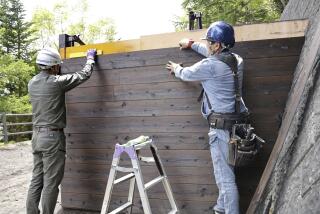Little Room Left to Bury the Dead in Crowded Japan
- Share via
TOKYO — Japan is crowded in death as well as in life.
Despite mandatory cremation, cemeteries across Japan have become so congested that officials estimate that graveyards will be completely full within a decade--and the government is hurrying to find alternatives.
“Within 10 years, citizens will not be able to use the cemeteries,” said Masao Fujii, professor of sociology and anthropology at Taisho University and head of a government commission that recently completed a two-year study of the problem.
Graveyards, particularly urban grounds, “will soon be full,” he said. “It will be necessary to have a new style of memorialization.”
The Japanese cemetery of the 21st Century will be high-rise and low-cost, Fujii and others believe. The modern alternative to the traditional plot will be a kind of burial box stacked locker-room style in a wall.
Acceptance Expected
Current attempts to attract users to these new sanctums have been less than successful, but Fujii said he was confident that “they will begin to be accepted” in the future.
Traditionally, the Japanese place the ashes of the deceased in stone family tombs similar to those used in Western Christian cemeteries. But attitudes toward the dead differ greatly from the West.
According to Japan’s Buddhist beliefs, the living must care for the dead, and in return the ancestors carefully watch over those still on Earth.
For seven days the spirit hovers near the grave, then becomes a Buddha, and finally joins the ancestral spirits. The grave is an important meeting ground and, although most families maintain shrines to the dead in the home, visits to the cemetery are frequent.
“An alternative for a grave may be hard to imagine, for it is a family shrine and as such must bear conformity with tradition,” said a recent editorial in the English-language newspaper Japan Times. It recommended abolishing a law against scattering ashes at sea as a way of alleviating some crowding.
Living Encroaching on Dead
Only a third of Japan’s mountainous terrain is inhabitable, and a large majority of the nation’s 120 million people are squeezed into urban areas. City graveyards began to feel the pinch about 20 years ago, with the encroachments of the living and increased demand for plots as more families opted for burial away from the husband’s ancestral gravesite.
The number of cemeteries also began to decline, according to Hisashi Noguchi of the Health and Welfare Ministry’s Environmental Health Bureau, because of road construction and other development projects. Japan had 883,896 graveyards in 1984, down from 916,654 in 1983.
Tokyo’s eight metropolitan graveyards filled up 20 years ago. One cemetery laid out 15 years ago in suburban Hachioji to hold the overflow has rationed off only 1,000 plots annually for the last four years and will close next year. One of Japan’s largest burial grounds, the 25,000-plot Fuji Cemetery, two hours outside Tokyo, will close in nine years.
Fujii’s commission recommended in its report constructing “wall-style” cemeteries, patterned after columbariums it studied in seven European nations.
Possible designs vary from long white outdoor memorial walls to eight-story, pagoda-shaped buildings, each filled with family vaults.
Cheap Alternatives
The Japanese, however, are not totally unfamiliar with modern graveyards. Prototypes have been tried, first as cheap alternatives for poor families and later as more efficient ways to use land, and have been almost completely rejected.
One new-style memorial in Kawasaki City has filled fewer than half of its 11,000 vaults, and most similar burial buildings have “not been popular,” Fujii said.
Prices vary. The boxes can cost as little as $25 for a five-year period, or as much as a traditional ground plot. The lifetime cost of an old-style plot in a temple burial ground averages $3,000, said Fujii.
A survey by the Japan Cemetery Assn. found that 75% of those polled believed that wall-style cemeteries were a “good idea,” but only 8% would like to be buried in one.
More to Read
Sign up for Essential California
The most important California stories and recommendations in your inbox every morning.
You may occasionally receive promotional content from the Los Angeles Times.













